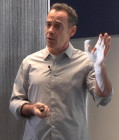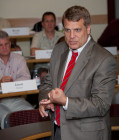Why A Well-Functioning Legislature Requires a Balance of Sunshine and Secrecy
Connect with the author
Transparency is usually seen as an unmitigated good. But new research by the Congressional Research Institute traces several types of legislative dysfunction to the dramatic expansion of legislative transparency in Congress and state legislatures that began with the “sunshine reforms” of the 1970s.
The framers of the Constitution recognized that healthy deliberation requires a degree of secrecy. The negotiations in Philadelphia that led to the Constitution were conducted in strict secrecy, with windows shuttered and guards posted at the doors. Had the deliberations been made in public, said Hamilton, “the clamors of faction would have prevented any satisfactory result.” The framers also wrote secrecy into the Constitution itself. Article 1 directs each chamber of Congress to “keep a Journal of its Proceedings, and from time to time publish the same, excepting such Parts as may in their Judgment require Secrecy.”
For two centuries, Congress operated under what may be considered a “balanced” regime that was partly open and partly closed. While committee hearings were often open to the public, committee mark-up sessions, in which legislative language is drafted, were as a rule conducted behind closed doors. The full House of Representatives debated and amended legislation under a special set of streamlined rules (the so-called “Committee of the Whole”), in which individual votes were not recorded. But in both chambers, final votes on the passage of bills were recorded, with each member’s individual vote going on record.
The History and Poor Record of the "Sunshine Reforms"
In the 1970s, sweeping transparency reforms were instituted in Congress. State legislatures followed suit. The stated goal was to give citizens greater access to the legislative process. Research into the functioning of Congress before and after the reforms reveals the following:
Opening committee deliberations increases “hard lining” and polarization – Opening committee deliberations and mark-up sessions to the public (and later to televisions cameras) made it harder for committees to forge compromises and – in the opinion of many participants and observers – reduced the quality of legislation. The committee dysfunction can be attributed to members’ reluctance to engage in a candid exchange of opinions in open meetings and to “hard lining,” the tendency of members to adhere strictly to a party line to please external audiences. The trend of increasing partisan polarization of Congress since the 1970s can be plausibly attributed at least in part to the increase in Congressional transparency
Recording votes while amending legislation incentivizes “gotcha!” tactics over productive discussion – The opening of more committee meetings and recording of more votes (e.g., in the House’s Committee of the Whole) introduced a new dysfunctional dynamic. Legislators were now incentivized to introduce amendments on hot-button issues, not for the purpose of improving legislation, but to put opponents on the record. These were sometimes called “November amendments” as the resulting votes were often used as fodder for “smear” campaigns in the next election. The glut of useless and malicious amendments so gummed up the legislative process in the House that by the late 1970s leaders began to introduce arbitrary constraints to limit the offering of amendments. These arbitrary constraints – including “closed rules,” which bar all amendments except from the committee reporting the bill – prevent rank-and-file legislators from participating in the process.
“Public access” really means “lobbyist access” – Granting “the public” greater access to the legislative process has had the practical effect of empowering and emboldening special interests, who are better positioned than members of the public to take advantage of open committee meetings and recorded votes. There is no evidence that members of the public are better informed about Congressional activity now (after the sunshine reforms) than they were before 1970. But lobbying dramatically increased in the 1970s by every metric. And evidence gathered from legislators, their staff, and lobbyists themselves confirms this change. No longer required to wait “in the lobby,” lobbyists now have a much greater role in setting the legislative agenda, drafting and amending legislative language, and shepherding bills through Congress.
Ways Forward
Today, legislators write popular, bipartisan laws by working around transparency rules. Many of the most impressive examples of public-spirited, bipartisan legislation in the post-reform era (e.g., the tax reform bill of 1986, the Clean Air Act amendments of 1990) were negotiated behind closed doors, despite loud protests from transparency advocates. Since the 1980s, the staunchest advocates of legislative transparency have not been the good-government organizations that promoted sunshine in the 1970s, but the lobbyists and interest groups who directly benefit from a transparent regime.
The opportunity to improve transparency rules is coming. Congress is currently debating a new round of legislative reorganization. A Select Committee on the Modernization of Congress is conducting hearings. The Committee should consider not only to the frequently touted benefits of transparency, but also the costs. The Committee should examine how the transparency reforms of the 1970s changed Congress in terms of culture, effectiveness, and output.


